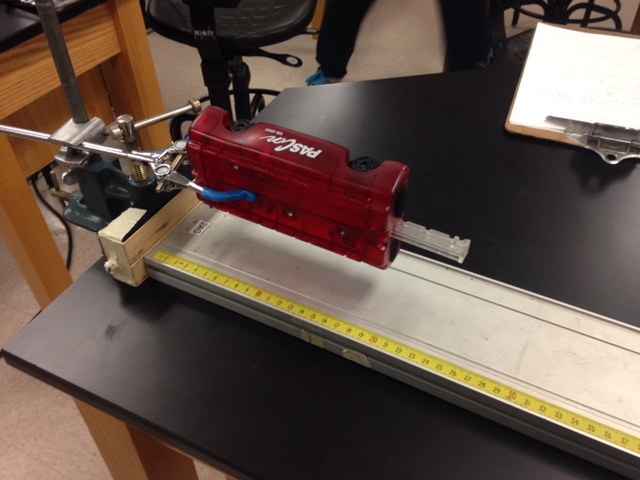The purpose of this lab was to determine the impulse of a cart when it experiences inelastic and elastic collisions.
Apparatus:
The apparatus required three setups and consisted of a cart track, two carts, a force sensor, a motion sensor, clay, and a nail. All the setups required for one cart to be on the track with the force sensor attached to the cart and a motion sensor on the opposing side of the collision as seen below:
The first setup specified that the cart would complete an elastic collision and would collide into another cart while the force sensor recorded the force exerted in the collision and the motion recorded its position as seen below:
The second would require the same actions only with additional mass attached to the colliding cart
The final setup would substitute the stationary cart with a clump of clay which caused the colliding cart to experience an inelastic collision. A nail would be attached to the force sensor in order for the cart to stop when becoming intact with the clay:
Experiment:
Before performing any of the experiments we first setup the sensors using logger pro on the laptop. Once the sensors were set we proceed to conduct the experiment for the first setup. Here we pushed the cart towards the opposing cart and recorded its velocity, force experienced, and position generating the graph below:
Before analyzing the force vs time we recorded the mass of the cart and determined the change in velocity in order to compare our calculations of the change in momentum with the actual value of the impulse.
momentum = Mass*(velocity final - velocity initial)
ΔP = (0.39 kg)*(-0.406 m/s - 0.452 m/s)
ΔP = -0.3346 Ns
Impulse = -0.3566 Ns
The experiment for the second experiment was exactly the same with the only change of adding mass the cart. After the experiment once again logger pro generated graphs for force, velocity, and position:
ΔP = (0.89 kg)*(-0.193 m/s - 0.299 m/s)
ΔP = -0.4378 Ns
Impulse = -0.4644
Although the velocity of the cart in this experiment is slightly smaller than that of the first experiment the impulse is greater meaning that both mass and velocity have an effect on the impulse.
The final experiment consisted of the same step only substituting the stationary cart with a clump clay resulting in the graph below:
ΔP = (0.39 kg)*(0 m/s - 0.487 m/s)
ΔP = -0.1928 Ns
Impulse = -0.2005
Conclusion:
After conducting the experiment we can verify that mass and velocity play a big role in determining the value for the change of momentum in an object as well as the force and time that effect impulse.






No comments:
Post a Comment